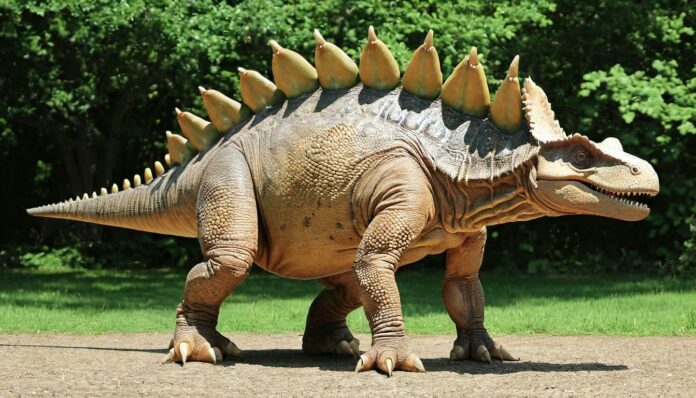The Stegosaurus was a large, plant-eating dinosaur that lived during the late Jurassic period, about 150 million years ago. It is easily recognized by the distinctive, double row of large, bony plates along its back and the sharp spikes on its tail, known as the thagomizer, which were likely used for defense against predators.
Stegosaurus had a small head, indicating it had a relatively small brain compared to its body size, and it moved slowly on all four legs.
Interesting Facts About Stegosaurus
- Time Period: Stegosaurus lived about 150 million years ago during the late Jurassic period.
- Location: Fossils have been found in North America and Europe.
- Name Meaning: The name “Stegosaurus” means “roofed lizard” due to its plate arrangement.
- Length: Stegosaurus could grow up to 30 feet long.
- Height: It stood about 14 feet tall at the hips.
- Weight: Stegosaurus weighed around 5 to 7 tons.
- Plates: It had 17 to 22 plates along its back.
- Plate Function: The plates might have been used for display, thermoregulation, or protection.
- Tail Spikes: Its tail had four long spikes, called the thagomizer.
- Defense: The thagomizer was likely used to fend off predators.
- Brain Size: Stegosaurus had a small brain, roughly the size of a walnut.
- Diet: It was herbivorous, feeding on low-lying plants.
- Teeth: Stegosaurus had small, leaf-shaped teeth suitable for chewing plants.
- Movement: It walked on all four legs, making it a quadruped.
- Speed: Stegosaurus was a slow mover due to its heavy body.
- Tail: The tail was flexible and could be swung with force.
- Discovery: The first Stegosaurus fossil was discovered in 1877 by Othniel Charles Marsh.
- Species: There are several known species, including Stegosaurus stenops and Stegosaurus ungulatus.
- Habitat: It lived in a semi-arid environment with seasonal rainfall.
- Nostrils: Stegosaurus had nostrils located near the front of its snout.
- Eyes: Its eyes were located on the sides of its head, giving it a wide field of vision.
- Posture: It held its head low to the ground.
- Social Behavior: There is evidence suggesting Stegosaurus may have lived in groups.
- Skeleton: Complete skeletons are rare; most reconstructions are based on partial remains.
- Brain Function: Despite its small brain, Stegosaurus had a complex nervous system.
- Cultural Impact: Stegosaurus is one of the most popular and well-known dinosaurs.
- Fossil Sites: Significant fossil sites include the Morrison Formation in the western United States.
- Reproduction: Like other dinosaurs, it is believed Stegosaurus laid eggs.
- Juveniles: Juvenile Stegosaurus fossils show that they grew rapidly.
- Extinction: Stegosaurus went extinct about 145 million years ago, before the end of the Jurassic period.
Stegosaurus remains one of the most iconic dinosaurs, known for its unique appearance and impressive defensive adaptations.
